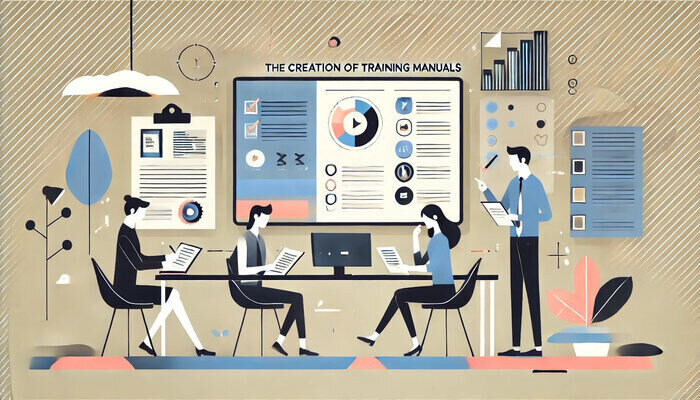
The development of a training manual is indispensable for any organization aiming to streamline its training procedures and maintain consistency in knowledge dissemination. Whether for onboarding employees or introducing new processes, a well-structured training manual can be invaluable. Here’s how you can create an effective training manual.
What Is a Training Manual and Why Is It Important?
A training manual is a comprehensive sourcebook designed to provide detailed guidelines, instructions, and resource support necessary for performing specific job functions or field training. It aids the learning process by outlining procedures, best practices, and essential concepts related to the program.
A typical training manual contains:
- Comprehensive coverage of relevant procedures, protocols, and best practices.
- Illustrations and examples to enhance understanding.
- Exercises to make the material practical and actionable.
It serves as a reference tool during and after the training to ensure that critical information is available when the user is building his or her skills and knowledge.
Let’s consider a real-life scenario where a training manual is essential for onboarding: a new nurse joining a hospital.
In major urban hospitals, training is critical for ensuring patient safety, compliance with hospital policies and procedures, and integration into the professional team. The complexities of medical procedures, equipment use, and regulatory requirements highlight the need for a training manual.
- First, the training manual outlines standard operating procedures, such as medication administration, patient assessment, and emergency response protocols. This consistency helps minimize mistakes and oversights.
- Healthcare facilities must adhere to numerous regulations set by medical authorities. The training manual incorporates these official regulations and emphasizes the importance of compliance, which is crucial for both accreditation and funding.
- Additionally, nurses must be familiar with various medical equipment used in the hospital, such as IV pumps, monitors, and diagnostic machines. The manual provides instructions on handling this equipment and troubleshooting common issues.
- The manual also includes guidelines and best practices for patient care, covering infection control, patient privacy (HIPAA), and cultural competency protocols.
- Emergency procedures are another critical aspect. Hospitals must be prepared for any situation, and the manual details protocols for responding to emergencies, including code situations and evacuation plans. This resource ensures that new nurses are ready for high-pressure scenarios.
- And, finally, the manual serves as an ongoing reference tool, supporting nurses throughout their careers. It helps reinforce best practices and provides guidance when they encounter unfamiliar situations.
In this case, the training manual is a vital part of the onboarding process for new nurses. It equips them to meet hospital standards and prioritize patient safety, ensuring higher-quality care.
Types of Training Manuals
The format and structure of training manuals are crucial for the development and delivery of effective training programs. Different types of training manuals cater to various learning styles, objectives, and environments. Here, we examine some of the most common types of training manuals you are likely to encounter.
Standard Operating Procedures (SOPs)
SOP manuals provide step-by-step instructions to ensure that every activity is performed with consistent quality. They are particularly useful in manufacturing industries, healthcare, and food services, where safety and quality depend on adhering to specific processes. SOPs typically outline the guidelines to follow, materials required, and troubleshooting tips if issues arise.
Employee Handbooks
An employee handbook is a comprehensive guide for new hires regarding company policies, procedures, and workplace culture. This manual helps employees understand their roles and responsibilities, as well as their rights and benefits. It usually includes sections on the code of conduct, dress code, attendance policy, and performance expectations.
Technical Manuals
Technical manuals are commonly used in IT or engineering fields to provide detailed information about specific technologies, systems, or equipment. These manuals help users gain a technical understanding necessary for operating or troubleshooting complex systems. They often include diagrams, technical specifications, and advanced troubleshooting steps.
Trainer Guides
Trainer guides assist trainers in delivering training programs effectively by providing an outline of the training session, objectives, instructional strategies, and activities. They may also include tips for engaging participants and evaluating learning outcomes, making them essential for effective training delivery.
Trainee Workbooks
Trainee workbooks are designed for participants and offer additional materials to supplement their learning. They may include exercises, case studies, reflective questions, and space for notes. Workbooks can enhance participation and reinforce key concepts learned during the training.
Multimedia Training Manuals
With advances in technology, multimedia training manuals are becoming increasingly popular. They incorporate videos, audio, interactive exercises, and other visual aids to create an engaging learning experience. These manuals can be available on various platforms, providing flexible training options for individual learners with diverse preferences.
E-Learning Modules
E-learning modules present training content in a digital format. Most of these modules are self-paced, allowing learners to progress through the material at their own speed. E-learning modules can include interactive elements such as quizzes and simulations to enhance learning effectiveness.
Choosing the right type of training manual is crucial for achieving the desired training outcomes. Understanding the different types will help organizations select resources that best address the unique needs of their trainees, making the learning process more effective. Whether it’s a straightforward SOP, an interactive multimedia module, or a detailed employee handbook, the right manual can significantly impact the success of the training.

The Essentials of Writing a Training Manual
Identifying the Purpose and Audience
Before you begin writing, it’s essential to understand the purpose of the training manual. To stay focused, consider the following questions:
- What is the purpose of this manual? Clearly define the results you want to achieve. Are you orienting new employees to company procedures, guiding users through a software step-by-step, or upgrading the skills of experienced personnel?
- Who is the audience? Identify the readers of the manual. Is it intended for new hires, seasoned staff, or a specific department? Knowing your audience allows you to tailor the content to their level of knowledge and experience.
- What competencies or knowledge should the reader gain? Determine the key competencies or knowledge you want the target audience to acquire from the manual. This could range from basic operational knowledge to more complex concepts. Ensure that your content aligns with these learning objectives.
Understanding these elements – purpose, audience, and intended learning outcomes – is crucial for structuring, wording, and creating content that will be valuable to your readers.
Scoping Information
Gather all necessary information, resources, and material that shall go into the manual. This includes:
- Subject matter expert interviews
- A review of existing documentation
- Training needs analysis
Ensure you have a thorough understanding of the topic to address current and relevant issues effectively.
Structuring the Content
Structure your manual in a logical order. Typically, a standard training manual should contain:
- Introduction: An overview of the manual’s content and objectives.
- Table of Contents: A guide to navigate through the document.
- Chapters/Sections: Divided into detailed, manageable chunks of information.
- Conclusion: A summary and recommendations for subsequent actions.
- Appendices: Additional resources or references.
Use headings and subheadings to ensure clarity and improve the accessibility of the manual.
Creating Easy to Read, Understandable, and Concise Content
Within the framework of content writing:
- Use simple, plain language free of jargon.
- Be direct and to the point.
- Employ active voice for clear descriptions of the steps.
- Include examples, scenarios, or case studies where applicable. The goal is to make the content as accessible as possible.
Inserting Pictures
Include visual material such as diagrams, charts, and pictures to illustrate information in a way that is easier for readers to understand and navigate. Visuals are important because they:
- Break up text. They divide large blocks of text making the content less daunting.
- Clarify complex topics. Visuals can simplify complex information, making it easier to grasp.
- Engage visual learners. Many people are visual learners, and visuals can aid in their retention of information.
- Improve UX: Effective graphics enhance the user experience by making the manual more interactive and reader-friendly.
Ensure that all visuals are of high quality, relevant, and contribute positively to the learning experience.
Adding Interactive Elements
Where appropriate, interactive elements can be embedded in the training manual to enhance engagement:
- Quizzes or self-assessment tools
- Checklists or worksheets
- Hyperlinks to additional resources or videos
Interactive elements can reinforce learning and improve retention.
Reviewing and Revising
Once the draft is prepared, review the content to make revisions. Check for grammar and typos, ensure consistent style and formatting, and verify the accuracy of the information. It’s advisable to have more than one person review the manual, as this can help identify errors or omissions.
Testing the Manual
Finally, test the manual with a small group from your target audience. Gather feedback on clarity, comprehensibility, content relevance, and overall usability. Take note of this feedback and make the necessary adjustments.
Finalizing and Distributing
Once revisions are complete, finalize the manual. Consider the following formats for distribution:
- Print copies for physical distribution
- Digital formats for easy access and sharing (e.g. PDF, eBook, HTML)
- Online platforms or intranet for company-wide access
Ensure the manual is easily accessible to the intended users.
Regular Updates
A training manual is a living document. Keep it updated with new information, processes, or feedback. Schedule regular reviews and revisions to ensure the content remains fresh and relevant.
Create Efficient Training Manuals with ClickHelp
Training manuals are crucial for quick and successful onboarding. With ClickHelp, you can create highly effective and engaging training manuals effortlessly. Here’s why:
- Centralized storage for training manuals: Get a centralized repository for all types of documents, including training manuals. Your users will find what they need in seconds without sifting through numerous links and documents.
- Multiple versions of training guides: In large organizations, different departments may require different training manuals. Create multiple versions of the same manual and efficiently reuse content.
- Easy to update training materials: Update learning materials quickly and efficiently, saving time and effort. Single-sourcing features give contributors better control over the content update process.
- Rich content for training manuals: Enhance your training documentation by adding images, screenshots, tables, and videos to boost user engagement and make information more digestible.
- Effective navigation elements: Select appropriate navigation features like TOC, mini-TOC, breadcrumbs, and more to help users easily find relevant topics.
- Track statistics: Use ClickHelp’s reports to evaluate project readiness, reader feedback, article popularity, and text readability. This helps you identify which sections are helpful and which need updating.
By leveraging ClickHelp, you can streamline the creation of training manuals, ensuring they are efficient, engaging, and accessible to all users.

Conclusion
Writing a training manual is a challenging process that requires careful planning and execution. These steps will help you develop a comprehensive and effective training manual that will be valuable to your organization. Remember, the success of a training manual depends on the clarity of the information, its ability to engage readers, and its up-to-date content.
With ClickHelp, you can enhance the onboarding experience, provide valuable resources to your team, and keep your training materials current and relevant. Start your journey toward creating exceptional training manuals.
Good luck with your technical writing!
Author, host, and deliver documentation across platforms and devices.

